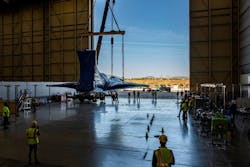NASA X-59 returns to California for final integration
PALMDALE, Calif., - NASA’s X-59 Quiet SuperSonic Technology (QueSST) research aircraft has returned to Lockheed Martin Skunk Works in Palmdale, California, following the completion of a series of ground tests in Fort Worth, Texas. While at the Texas facility, structural and fuel calibration tests were completed on the aircraft in preparation for final integration and taxi testing back in Palmdale. The X-59 QueSST is part of NASA’s low-boom flight demonstration mission, which will test technology designed to reduce “the loudness of a sonic boom to a gentle thump to people on the ground," Kate O'Connor reports for AVWeb. Continue reading original article.
The Military & Aerospace Electronics take:
20 April 2022 - Ground tests on the X-59 were done to ensure the aircraft’s ability to withstand the loads and stresses of supersonic flight – or flight at speeds faster than Mach 1. The vehicle’s fuel systems were also calibrated and tested at Lockheed Martin’s Ft. Worth facilities. With its return to California, the X-59 will undergo further ground tests as it approaches full completion of its development and continues to make progress on its way to first flight.
The X-59 is designed to fly faster than the speed of sound without producing the typically loud sonic booms that occur when an aircraft flies at supersonic speeds. The advanced X-plane will instead reduce that sound to a quiet sonic “thump”, which will be demonstrated in flights over communities around the U.S. starting in 2024. NASA’s goal is to collect and provide data to regulators that may finally solve the sonic boom challenge and open the future to commercial supersonic flight over land, reducing flight times drastically.
Related: Ames' contributions to the X-59 quiet supersonic technology aircraft
Related: NASA Langley works to revive supersonic flight - without sonic booms
Related: Civilian and military aircraft get avionics upgrades
Jamie Whitney, Associate Editor
Intelligent Aerospace
